In the realm of fitness, one body part often highlighted for both its aesthetic and functional significance is the chest. More specifically, the pectoral muscles play a significant role not only in sporting activities and everyday tasks but also in lending a robust, balanced appearance to the physique. Achieving a defined chest is a common goal for many fitness enthusiasts and can greatly contribute to overall strength and confidence.
The chest muscles are comprised of two primary segments, the clavicular head (or upper chest) and the sternal head. The sternal head is further divided into mid and lower chest. For a comprehensive, well-defined chest, all areas need to be targeted and trained efficiently. While several exercises focus on the upper chest, the importance of the lower chest is often understated.
The lower chest, also known as the lower pectorals or lower pecs, is the portion of the chest that gives the pecs their full, rounded appearance. It’s this area that completes the “chest shelf,” and without adequate development, the chest can appear incomplete or imbalanced. Therefore, it’s crucial to include exercises that isolate and target this area in your workout regime. Through targeted exercises, one can effectively define and sculpt the lower chest, leading to a more balanced and impressive physique.
This article will guide you through the top 5 lower chest exercises for a truly defined chest. These exercises have been specifically chosen for their effectiveness in targeting and isolating the lower chest muscles, and can help you carve out that coveted chest contour you’ve been striving for.
Pre-Exercise Guidelines
Before delving into the specific exercises that can help chisel your lower chest, it’s crucial to cover some preliminary yet essential points. These guidelines will not only improve the efficiency of your workout but also ensure your safety and long-term progress.
Importance of Proper Warm-Up
A well-executed warm-up session is the first step to any effective workout. A good warm-up gradually increases your heart rate, improves blood circulation, and prepares your muscles for the strenuous activity to come. Focusing on the chest, shoulders, and upper back during your warm-up will specifically prime these areas for the chest workout. Dynamic stretches or light cardio can effectively serve this purpose.
The Significance of Maintaining Correct Form and Posture
The importance of maintaining proper form during exercise cannot be overstated. A correct form ensures that the right muscle groups are targeted and reduces the risk of injury significantly. For instance, an incorrectly performed chest exercise might strain your shoulders or back instead of focusing on the pectoral muscles. The key is to perform each movement slowly and with control, prioritizing quality over quantity.
Factors Affecting Muscle Growth
As you embark on your journey towards a more defined lower chest, it’s essential to remember that exercise is only one piece of the puzzle.
Diet plays a crucial role in muscle growth and recovery. Consuming a balanced diet rich in protein, healthy fats, and carbohydrates will provide your body with the necessary nutrients to build and repair muscles. Stay hydrated and consider seeking professional advice to further refine your dietary needs.
Rest is equally important. Our muscles grow and repair during rest periods, particularly during sleep. Make sure you are getting 7-9 hours of quality sleep each night and allowing adequate rest days between intense workout sessions.
Finally, workout intensity matters. Progressive overload, or gradually increasing the weight, reps, or intensity of your workouts, is key to continuous muscle growth. While it’s essential to challenge yourself, remember to listen to your body and avoid pushing beyond your limits to prevent injuries.
Keeping these pre-exercise guidelines in mind will set you up for a successful lower chest workout and help you maximize your results.
The 5 Best Lower Chest Exercises
1. Decline Bench Press
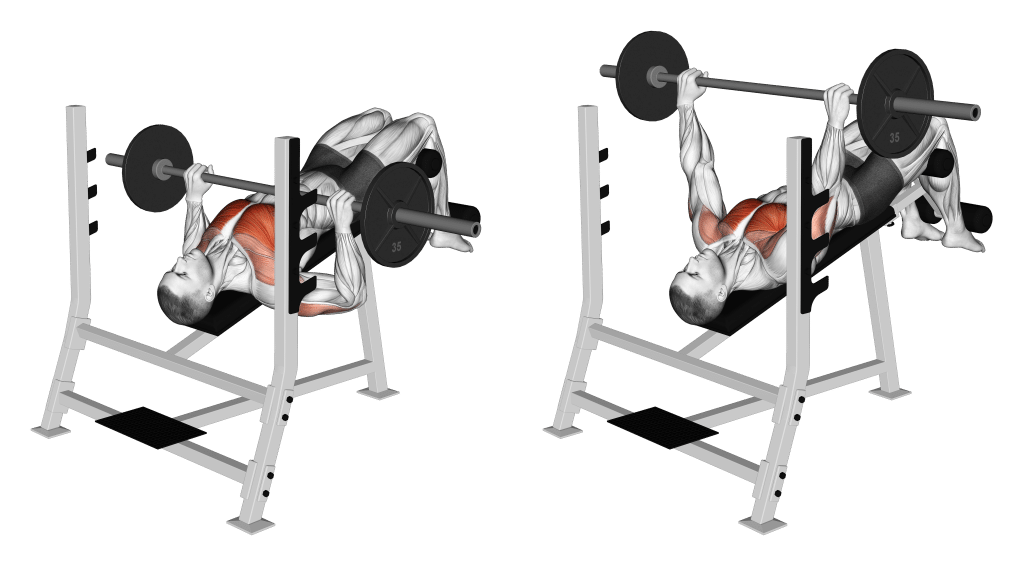
The decline bench press is a popular and effective exercise that targets the lower pecs. It involves lifting weights on a bench that is angled downward, which allows the exercise to focus more on the lower chest, as compared to flat or incline bench press.
Procedure and Tips for Performing it Correctly
Start by setting up your bench at a 30 to 45-degree decline. Lie back on the bench with your feet securely hooked under the foot pads. Grab the barbell with your hands a bit wider than shoulder-width apart.
Unrack the barbell and slowly lower it to your lower chest. Keep your elbows at about a 45-degree angle to your body to reduce strain on the shoulders. Once the barbell touches your chest, push it back up to the starting position, focusing on contracting your lower pecs.
Remember, the movement should be slow and controlled. Avoid bouncing the bar off your chest or locking your elbows out completely at the top.
Benefits of the Decline Bench Press for Lower Chest Development
The decline bench press is a powerful exercise for isolating the lower pecs. By performing this movement on a decline, the muscle fibers of the lower chest are engaged more than in a flat or incline press. This increased activation can lead to greater muscle growth and development in the lower chest, thereby enhancing the overall definition and fullness of your pecs.
Incorporating the decline bench press into your routine can also improve your pushing strength, which can be beneficial for both athletic performance and daily activities. In addition, this exercise engages the triceps and shoulders, making it a comprehensive upper body workout.
By mastering the decline bench press and performing it regularly, you will be well on your way to carving out a robust and defined lower chest.
2. Dips – Chest Version
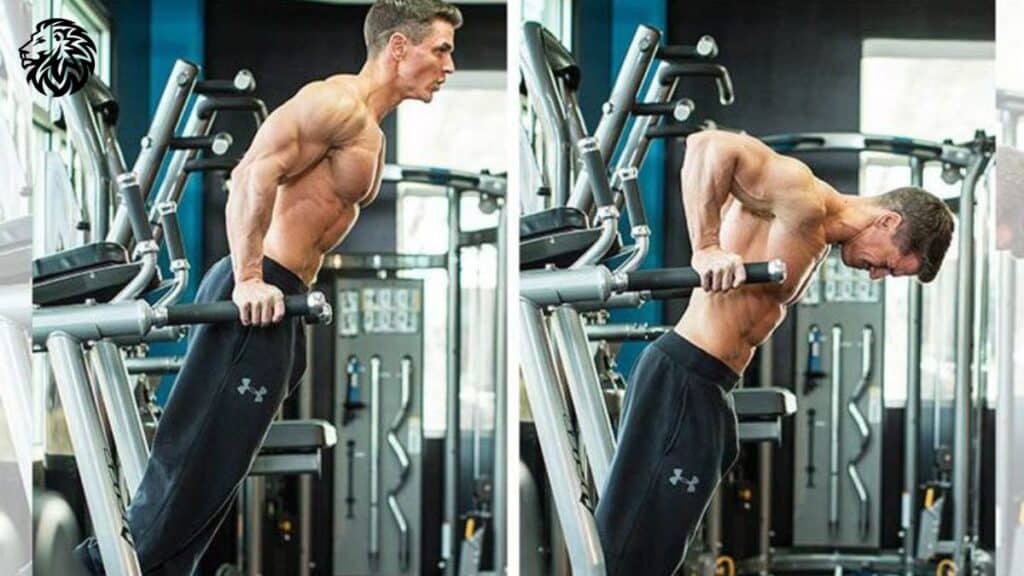
Dips are a fantastic compound exercise that targets several muscle groups in your upper body, including the chest, triceps, and shoulders. When performed with a slight modification – leaning forward – dips become an excellent exercise for the lower chest.
Step-by-Step Guide on How to Perform Dips
Begin by hoisting yourself up on parallel bars, gripping the bars firmly and keeping your arms straight. Your body should be upright, and your legs crossed or bent at the knees to prevent them from touching the ground.
To specifically target the lower chest, lean your torso forward slightly. Lower your body by bending your arms, aiming to get your shoulders just below your elbows at the bottom of the movement. Push yourself back up to the starting position, squeezing your chest muscles as you do so.
Remember, maintaining control is essential throughout the movement. Avoid dropping down too fast or using momentum to push back up.
How Dips Target the Lower Chest Muscles
When performed with a forward lean, dips shift the emphasis from the triceps to the chest – specifically, the lower pecs. The downward and forward movement effectively stretches and activates the lower chest fibers, leading to stronger and more defined muscles in this area.
3. Cable Crossover – From Low Pulley
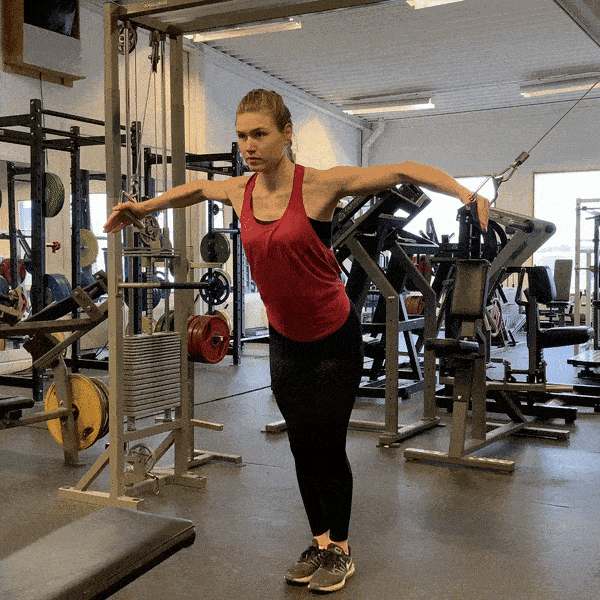
The cable crossover exercise, performed with cables set at the lower pulley position, is another effective way to target your lower chest. It’s a versatile and functional movement that involves a sweeping motion of the arms, engaging your pecs dynamically.
Instructions on How to Perform Cable Crossover Correctly
Start by positioning the pulleys at the lowest level. Stand in the middle of the cable machine, and grab each cable with your hands. Take a step forward to create tension in the cables. Bend your knees slightly and lean forward, maintaining a straight spine.
With a slight bend in your elbows, pull the cables upward and inward, crossing them over in front of your chest. Squeeze your chest muscles at the peak of the motion, then slowly return to the starting position.
Throughout the exercise, maintain control and move the cables slowly and deliberately, focusing on the muscle-mind connection.
The Benefits and Impact of Cable Crossover on the Lower Chest
Cable crossovers from a low pulley target the lower pecs effectively due to the upward sweeping motion. This exercise provides constant tension on the chest muscles, even at the end of the movement, leading to increased muscle activation and growth.
Cable crossovers also offer a range of motion that can’t be achieved with free weights, allowing for greater pec stretch and contraction. This comprehensive engagement of the chest muscles leads to a well-defined, muscular lower chest.
Moreover, as this is a single-joint movement, it’s easier to isolate the pecs, making it an excellent addition to your chest-focused workout.
4. Decline Dumbbell Flyes
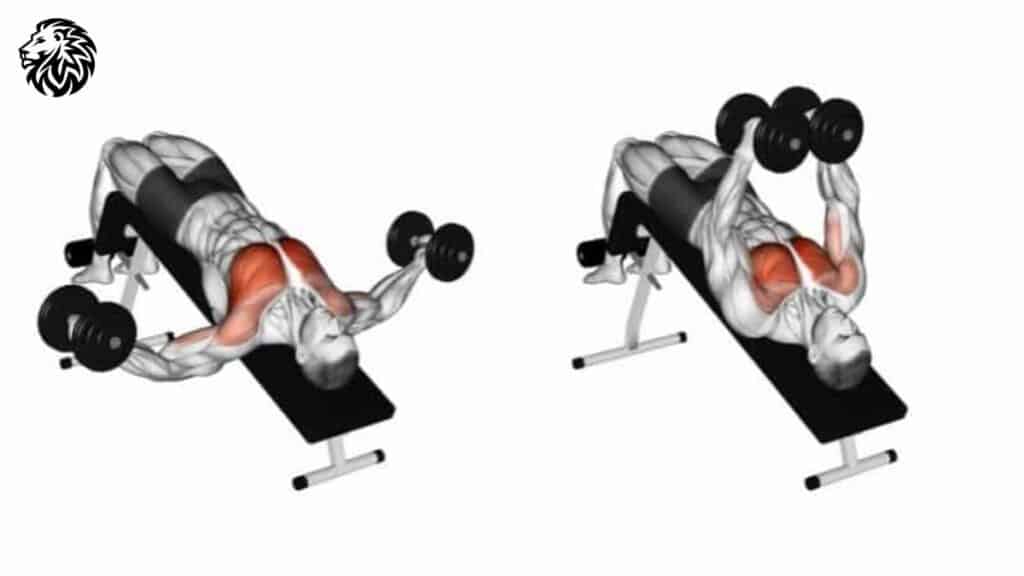
Decline Dumbbell Flyes are another stellar exercise that zeroes in on the lower pectorals. The exercise, similar to other fly movements, involves spreading your arms wide and then bringing them together, simulating the flapping motion of a bird.
Detailed Instructions on Performing Decline Dumbbell Flyes
Set your bench to a 30 to 45-degree decline. Lie on your back on the bench, with your feet firmly planted on the floor. Hold a dumbbell in each hand, extending your arms above your chest, palms facing each other.
Begin the exercise by lowering your arms out to your sides in a wide arc, maintaining a slight bend in your elbows to reduce stress on the joint. Once your arms are level with your chest, squeeze your pecs to reverse the motion and lift the weights back to the start position, as if you’re hugging a giant tree.
Ensure you keep the movement slow and controlled, focusing on the stretch and contraction of your lower chest muscles.
How Decline Dumbbell Flyes Can Help Shape the Lower Chest
Decline Dumbbell Flyes specifically target the lower chest due to the declined position of the bench. This positioning puts the lower pecs under greater tension, leading to increased muscle activation. The wide arc motion allows for a deep stretch of the pecs at the bottom of the movement, while the squeezing motion at the top effectively contracts them, facilitating optimal muscle growth.
5. Incline Push-ups
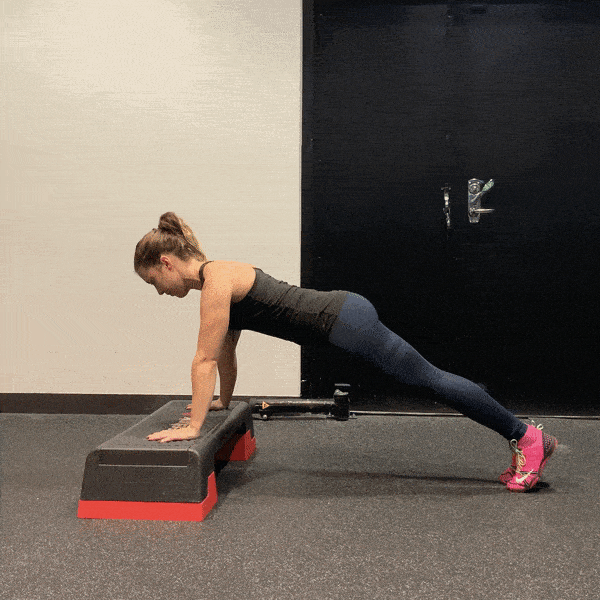
Incline push-ups are a variant of the traditional push-up where your hands are placed on an elevated surface. This alteration shifts the workload from the middle chest to the lower chest, making it a great exercise for defining the lower pecs.
Procedure for Performing Incline Push-ups
Find an elevated surface like a bench, step, or even a wall. Place your hands on the surface slightly wider than shoulder-width apart. Extend your feet behind you so you’re on your toes, forming a straight line from your head to your heels.
Lower your body towards the elevated surface by bending your elbows, keeping your body straight and your core engaged. Once your chest is just above the surface, push your body back to the starting position, squeezing your chest muscles as you do so.
Remember to keep your elbows close to your body to engage your chest more and reduce strain on your shoulders.
The Effectiveness of Incline Push-ups in Building the Lower Chest
Incline push-ups put more emphasis on the lower chest by changing the angle of the movement. This variant makes your lower chest work harder to push your body back up, leading to increased muscle engagement and growth in this area.
Incline push-ups are also great for beginners or those who find regular push-ups too challenging, as they are less demanding on your strength and endurance. However, they still offer excellent muscle-building benefits, making them a valuable addition to your lower chest workout routine.
Incorporating These Exercises into a Workout Routine
For significant muscle growth and definition, it’s generally recommended to target each muscle group, including your lower chest, two to three times per week. This frequency allows for a balance between training stimulus and recovery time, promoting optimal muscle growth. Be sure to incorporate rest days between your chest workouts to allow your muscles to repair and grow.
Progressive overload is a key principle in strength training and muscle building. It involves gradually increasing the stress placed on your body during workouts over time. This could mean increasing the weight you lift, the number of repetitions or sets you perform, or reducing your rest time between sets.
By progressively overloading your muscles, you encourage your body to adapt to the increasing demands, leading to improved strength and muscle growth. This principle is crucial for continuous progression and can be applied to all the exercises mentioned in this article.
Here is a sample workout routine that includes the five lower chest exercises covered in this article:
- Warm-up: 10 minutes of light cardio and dynamic stretching.
- Decline Bench Press: 3 sets of 8-12 repetitions.
- Dips – Chest Version: 3 sets of 10-15 repetitions.
- Cable Crossover – From Low Pulley: 3 sets of 12-15 repetitions.
- Decline Dumbbell Flyes: 3 sets of 10-12 repetitions.
- Incline Push-ups: 3 sets of 12-15 repetitions or to failure.
- Cool down: 5 minutes of static stretching focusing on chest and shoulders.
Adjust the weights, repetitions, and sets according to your current fitness level and goals. Remember, the key to muscle growth is consistency, proper form, and progressively challenging your muscles. With these exercises and principles, you’re on your way to achieving a defined and robust lower chest.
Conclusion
In this article, we’ve highlighted five powerful exercises – the Decline Bench Press, Dips, Cable Crossover from Low Pulley, Decline Dumbbell Flyes, and Incline Push-ups – all designed to focus on and build your lower chest muscles. Each of these exercises brings unique benefits to the table, from isolating the lower pecs, improving your overall upper body strength, to enhancing the aesthetics of your chest. Incorporating them into your routine can help you achieve a well-rounded, chiseled lower chest.
While these exercises are effective, achieving a defined chest doesn’t happen overnight. It’s a journey that requires consistency, patience, and discipline. Remember that progress is not always linear and varies from person to person. It’s crucial to stay consistent with your workouts. Eating a balanced diet and get adequate rest to support your muscle growth is essential.
As you work towards defining your lower chest, remember the importance of a balanced workout regimen. While it’s beneficial to target specific muscle groups, it’s equally important to ensure that all parts of your body are worked on equally. This will prevent imbalances that could lead to poor posture or injuries. Combining chest workouts with exercises for your back, legs, arms, and core will help you achieve well-rounded fitness.
With these tips and exercises in your arsenal, you’re equipped to forge ahead in your fitness journey and work towards a strong and defined lower chest. The journey to fitness is a marathon, not a sprint. Stay consistent and the results will come!
References and Further Reading
- Medical News Today. (n.d.). Everything you need to know about chest pain. Retrieved from https://www.medicalnewstoday.com/articles/324490
- Muscle & Fitness. (n.d.). 5 Best Exercises to Build Your Lower Chest. Retrieved from https://www.muscleandfitness.com/workouts/workout-tips/5-best-exercises-build-your-lower-chest/
- Healthline. (n.d.). 9 Effective Lower Chest Exercises. Retrieved from https://www.healthline.com/health/fitness-exercise/lower-chest-exercises%231
- Men’s Health. (n.d.). The Best Lower Chest Workout Moves to Build Your Pecs. Retrieved from https://www.menshealth.com/fitness/a39464129/lower-chest-workouts/
- Bodybuilding.com. (n.d.). 7 Training Tips to Power Up Your Lower Chest. Retrieved from https://www.bodybuilding.com/content/7-training-tips-to-power-up-your-lower-chest.html







